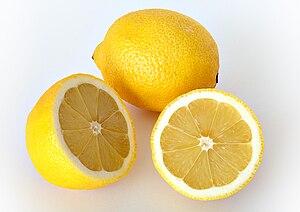Limonine
| Structural formula | ||||||||||||||||
|---|---|---|---|---|---|---|---|---|---|---|---|---|---|---|---|---|

|
||||||||||||||||
| General | ||||||||||||||||
| Surname | Limonine | |||||||||||||||
| Molecular formula | C 26 H 30 O 8 | |||||||||||||||
| Brief description |
crystalline solid |
|||||||||||||||
| External identifiers / databases | ||||||||||||||||
|
||||||||||||||||
| properties | ||||||||||||||||
| Molar mass | 470.50 g mol −1 | |||||||||||||||
| Physical state |
firmly |
|||||||||||||||
| Melting point |
298 ° C |
|||||||||||||||
| solubility |
|
|||||||||||||||
| safety instructions | ||||||||||||||||
|
||||||||||||||||
| As far as possible and customary, SI units are used. Unless otherwise noted, the data given apply to standard conditions . | ||||||||||||||||
Limonin is a crystalline solid and belongs to the group of limonoids .
properties
Limonine is a colorless crystalline solid at room temperature. The very bitter taste is characteristic. The bitter taste of a limonine solution is noticeable from a concentration of 0.75 μmol · l −1 . In mild conditions it is generally very resistant to oxidizing agents. At higher temperatures it burns completely.
Occurrence
Limonin occurs naturally in the kernels of numerous types of fruit, such as orange , lemon or mandarin kernels. In unripe fruits, it can also occur outside the core in the pulp. During the ripening process, this limonin is converted to limonene glucoside, which cannot be tasted. However, if limonine glucoside is in the presence of vitamin B 2 in sunlight, it breaks down to limonine, which makes the limonine-containing drink taste bitter.
Limonin in fruit juice production
The bitter taste of limonin has already been discussed among the properties. Orange juice can, for example, have a concentration of up to 40 μg / g. The bitter aftertaste can be felt in the mouth for up to an hour after ingestion. This high concentration occurs especially with early or unripe fruits. In industry it is therefore relevant to extract excess limonin and thus make the juices more enjoyable. Most juices have a concentration of the bitter substance of 4 to 6 μg / g at the end of the extraction process, which was also set as a limit value by the USDA .
Biological activity
In current research, limonin is also examined for its biological activity . The extract from the kernels of the fruits has an inhibiting effect on the retrovirus HIV-1 , which is known to cause AIDS. It also has an inhibitory effect on the HTLV-1 retrovirus . In addition, the compound has a neuroprotective effect and reduces the spread of colon cancer . Limonine was also tested in mice as an appetite suppressant .
Individual evidence
- ↑ a b c d e f g Jürgen Falbe, Manfred Regitz (ed.): Römpp Chemie Lexikon, 9th edition, Georg Thieme Verlag, Stuttgart 1990, ISBN 3-13-734809-9 , pp. 2513-2514.
- ↑ a b Entry on limonin at TCI Europe, accessed on June 23, 2017.
- ↑ G. Koller, H. Czerny: About limonin, the bitter substance in orange pits. In: Monthly books for chemistry and related parts of other sciences . , No. 67, 1936, pp. 248-268, doi: 10.1007 / BF0271602 .
- ↑ a b Stéphane C. Fayoux, Ruben J. Hernandez, Robert V. Holland: The Debittering of Naval Orange Juice Using Polymeric film. In: Journal of Food Science . , No. 72, 2007, pp. E143-E154, doi: 10.1111 / j.1750-3841.2007.00283.x .
- ↑ Andrew P. Breksa, Marlene B. Hidalgo, Rosalind Y. Wong: Stability of limonin glucoside in beverage matrices. In: Journal of the Science of Food and Agriculture . , No. 88, 2008, pp. 2194-2200, doi: 10.1002 / jsfa.3344 .
- ↑ Jeong Seon Yoon, Hyekyung Yang, Seung Hyun Kim, Sang Hyun Sung, Young Choong Kim: Limonoids from Dictamnus dasycarpus Protect Against Glutamate-Induced Toxicity in Primary Cultured Rat Cortical Cells. In: Journal of Molecular Neuroscience . , No. 42, 2010, pp. 9-16, doi: 10.1007 / s12031-010-9333-1 .
- ↑ Kotamballi N. Chidambara Murthy, GK Jayaprakasha, Vinod Kumar, Keerti S. Rathore, Bhimanagouda S. Patil: Citrus Limonin and Its Glucoside Inhibit Colon Adenocarcinoma Cell Proliferation through Apoptosis. In: Journal of Agricultural and Food Chemistry . , No. 59, 2011, pp. 2314-2323, doi: 10.1021 / jf104498p .
- ↑ Eri Ono, Jun Inoue, Tsutomu Hashidume, Makoto Shimizu, Ryuichiro Sato: Anti-obesity and anti-hyperglycemic effects of the dietary citrus limonoid nomilin in mice fed a high-fat diet. In: Biochemical and Biophysical Research Communications . , No. 410, 2011, pp. 677-681, doi: 10.1016 / j.bbrc.2011.06.055 .

